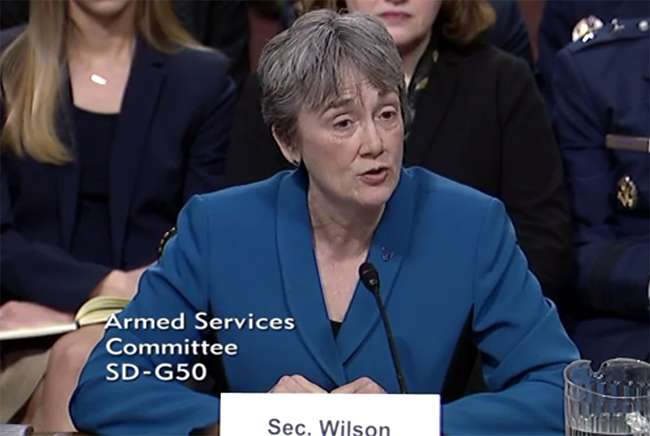
Air Force Secretary Heather Wilson testifies before the Senate Armed Services Committee on April 4, 2019, in Washington, D.C. SASC screenshot.
A new round of sequestration would cut the Air Force’s budget by about $29 billion if the US busts its spending limits set by the 2011 Budget Control Act, service Secretary Heather Wilson told senators Thursday.
Sequestration would leave the Air Force with two sets of options, she said: Either the service would stop buying F-35s, cut all KC-46s, stop the B-21 program, abandon the Ground-Based Strategic Deterrent effort, scrap space research and development initiatives, and end most fourth- and fifth-generation platform modifications. Or, it could do away with all weapon system sustainment, flying hours, base operations, air fleet support, and munitions programs, Wilson said.
“I think you can see that that would be absolutely devastating in scope and scale,” she said.
The Air Force lost $10 billion under sequestration in fiscal 2013, the Pentagon said that year.
Sequestration is again looming in 2020 and 2021, the last two years the BCA’s spending caps are enforced, unless lawmakers agree to raise the defense spending ceiling above $576 billion in 2020 and $591 billion in 2021. The BCA does not limit overseas contingency operations funding. Non-defense spending caps are set at $542 billion and $555 billion for the next two years.
If US spending exceeds those limits, the defense budget would automatically be slashed by $71 billion and non-defense by $55 billion below 2019 spending levels, according to the Center on Budget and Policy Priorities.
Another recurring financial threat—continuing resolutions—would cut into dozens of new construction and research programs. Military officials routinely warn lawmakers about the impact additional CRs would have on combat readiness and future capabilities, and Wilson this week offered examples of what that might look like for 2020.
“We’ve got 16 new military construction projects that wouldn’t start, and 18 for current missions’ military construction that wouldn’t start,” she said. “Also, we’ve got 89 research, development, test, and evaluation new starts in this budget that wouldn’t start.”
Sen. Tom Cotton (R-Ark.) asked what would happen if Congress can’t reach a deal to raise the budget caps and instead passes a CR spanning all of 2020—a proposal he says is being “batted around.”
In that case, Air Force Chief of Staff Gen. David Goldfein said the service would remain at 2019 funding levels and be forced to stop military construction needed for the KC-46, F-35, and T-X programs.
“You have to have the infrastructure to beddown the weapon systems,” he added. “If it goes anything more than six months, it would put our end strength growth at risk because we will not be able to bring on the additional airmen we need, not to have mission growth but actually to fill our formations to do the missions that we’re already doing.”
Facing several questions on Capitol Hill this week about the sustainability of annual defense budget increases and how the military is managing its money, Wilson said the Air Force will conduct another “zero-based review” for the 2021 budget cycle as it did for 2020.
“Our approach was to come up with a balanced budget that made us as lethal as we possibly could be,” she said. “We restructured our Next-Generation Air Dominance program. … We terminated the B-2 high frequency program. We put money into readiness and tried to focus that on the squadrons where it made the most difference, what we call our pacing units.”
Another major decision made last year was to cancel the E-8C JSTARS recapitalization program in favor of pursuing networked sensors instead of a dedicated jet.
A year ago, Wilson said the service had identified smaller programs worth less than $25 million or $30 million a year that tended to fly under the radar, but didn’t necessarily fit into the Air Force’s future priorities. Although the results of the first review were incorporated into the service’s 2020 budget plans, Wilson did not offer examples of what could be cut.